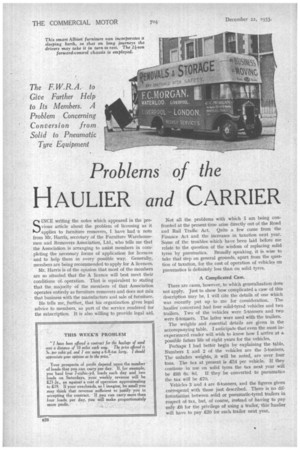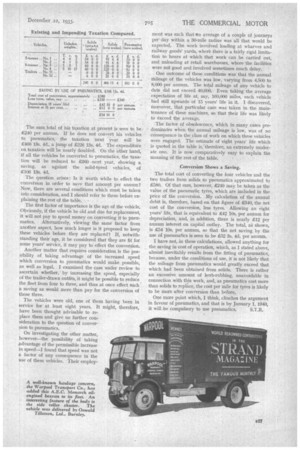Problems of the
Page 32

Page 33

If you've noticed an error in this article please click here to report it so we can fix it.
HAULIER and CARRIER
The F.W.R.A. to Give Further Help to Its Members. A Problem Concerning Conversion from Solid to Pneumatic Tyre Equipment
SINCE writing the notes which appeared in the previous article about the problem of licensing as it applies to furniture removers, I have had a note from Mr. Harris, secretary of the Furniture Warehousemen and Removers Association, Ltd., who tells me that the Association is arranging to assist members in completing the necessary forms of application for licences and to help them in every possible way. Generally, members are being recommended to apply for A licences.
Mr. Harris is of the opinion that most of the members are so situated that the A licence will best meet their conditions of. operation. That is equivalent to stating that the majority of the members of that Association operates entirely as furniture removers and does not mix that business with the manufacture and sale of furniture.
He tells me, further, that his organization gives legal advice to members, as part of the service rendered for the subscription. It is also willing to provide legal aid.
Not all the problems with which I am being confronted at the present-time arise directly out of the Road and Rail Traffic Act. Quite a few come from the Finance Act and the increases in taxation next year. Some of the troubles which have been laid before me relate to the question of the wisdom of replacing solid tyres. by pneumatics. Broadly speaking, it is wise to take that step on general grounds, apart from the question of taxation, for the cost of operation of vehicles on pneumatics is definitely less than on solid tyres.
A Complicated Case.
There are cases, however, to which generalization does not apply. Just to show how complicated a case of this description may be, I will cite the details of one which was recently put up to me for consideration. The haulier concerned had four solid-tyred vehicles and two trailers. Two of the vehicles were 5-tonners and two were 6-tOrmers. The latter were used with the trailers.
The weights and essential details are given in the accompanying table. I anticipate that even the most experienced reader will wish to know how I arrive at a possible future life of eight years for the vehicles.
Perhaps I had better begin by explaining the table. Numbers 1 and 2 of the vehicles are the 5-tonners. The unladen weights, it will be noted, are over four tons. The tax at present is £54 per vehicle. If they continue in use on solid tyres the tax next year will be £93 6s. 8d. If they be converted to pneumatics the tax will he 270.
Vehicles 3 and 4 are 6-tonners, and the figures given correspond with those just described. There is no differentiation between solid or pneumatic-tyred trailers in respect of tax, but, of course, instead of having to pay only £6 for the privilege of using a trailer, this haulier will have to pay £20 for each trailer next year. The sum total of his taxation at present is seen to be £240 per annum. If he does not convert his vehicles to pneumatics, the taxation 'next year will be £466 13s. 4d., a jump of 2226 13s. 4d. The expenditure on taxation will be nearly doubled. On the 'other hand, if all the vehicles be converted to pneumatics, the taxation will be reduced to £360 next year, showing a saving, as against the solid-tyred vehicles, of £106 13s. 4d.
The question arises : Is it worth while to effect the conversion in order to save that amount per annum? Now, there are several conditions which must be taken into consideration, and I should refer to these before explaining the rest of the table.
The first factor of importance is the age of the vehicle. Obviously, if the vehicle be old and due for replacement, it will not pay to spend money on converting it to pneumatics. Alternatively, viewing the same factor from another aspect, how much longer is it proposed to keep these vehicles before they are replaced? If, notwithstanding their age, it be considered that fhey are fit for some years' service, it may pay to effect the conversion.
Another matter that requires consideration is the possibility of taking advantage of the increased speed which conversion to pneumatics would make possible, as well as legal. I examined the case under review to ascertain whether, by increasing the speed, especially of the trailer-drawn outfits, it might be possible to reduce the fleet from four to three, and thus at once effect such a saving as would more than pay for the conversion of those three.
The vehicles were old, one of them having been in service for at least eight years. It might, therefore, have been thought advisable to replace them and give no further con sideration to the question of conversion to pneumatics.
On investigating the other matter, however—the possibility of taking advantage of the permissible increase in speed--I found that speed was not a factor of any consequence in the use of these vehicles. Their employ
merit was such that ikn average of a couple of journeys per day within a 30-mile radius was all that would be expected. The work involved loading at wharves and railway goods' yards, where there is a fairly rigid limitation to hours at which that work can be carried out, and unloading at retail warehouses, where the facilities were not good and involved sometimes much delay.
One outcome of these conditions was that the annual mileage of the vehicles was low, varying from 4,500 to 8,000 per annum. The total mileage of any vehicle to date did not exceed 40,000. Even taking the average expectation of life at, say, 160,000 miles, each vehicle had still upwards of 15 years' life in it. I discovered, moreover, that particular care was taken in the maintenance of these machines, so that their life was likely to exceed the average.
The factor of obsolescence, which in many cases predominates when the annual mileage is low, was of no consequence in the class of work on which these vehicles were engaged. The estimate of eight years' life which is quoted in the table is, therefore, an extremely moderate one. It is now comparatively easy to explain the meaning of the rest of the table.
Conversion Shows a Saving.
The total cost of converting the four vehicles and the two trailers from solids, to pneumatics approximated to £580. Of that sum, however, £240 may be taken as the value of the pneumatic tyres, which are included in the price of the conversion. My calculation of the annual debit is, therefore, based on that figure of £340, the net cost of the conversion, less tyres. Allowing an eight years' life, that is equivalent to £42 10s. per annum for depreciation, and, in addition, there is nearly £12 per annum interest on capital outlay. The total, a'S shown, is £54 10s. per annum, so that the net saving by the use of pneumatics is seen to be £52 3s. 4d. per annum.
I have not, in these calculations, allowed anything for the saving in cost of operation, which, as I stated above, almost inevitably results from the fitting of pneumatics, because, under the conditions col use, it is not likely that the mileage from pneumatics would greatly exceed that which had been obtained from solids. There is rather an excessive amount of kerb-rubbing, unavoidable in connection with this work, and, as pneumatics cost more than solids to replace, the cost per mile for tyres is likely to be more after conversion than before.
One more point which, I think, clinches the argument in favour of pneumatics, and that is by January 1, 1940, it will be compulsory to use pneumatics. S.T.R.












































































